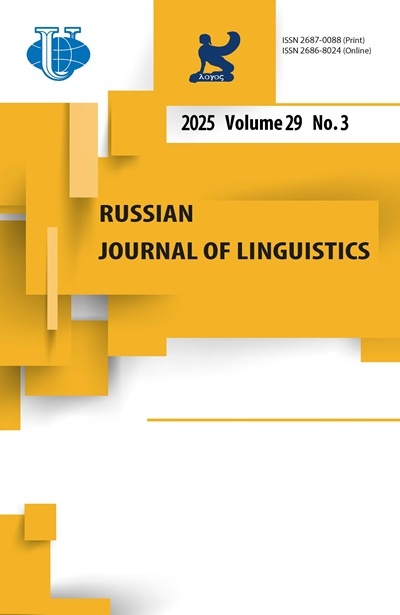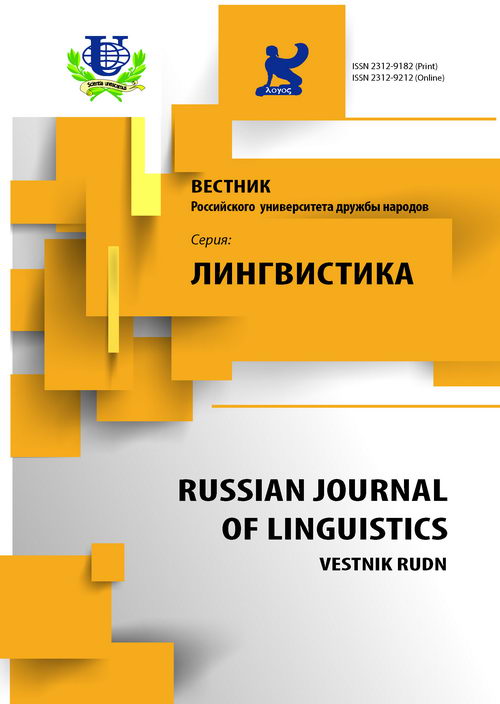Гиперо-гипонимические отношения терминологии, обозначающей связи с инвесторами (на материале тематической группы «номинация лиц, связанных с Investor Relations»)
- Авторы: Сарангова Т.А.1
-
Учреждения:
- Российский университет дружбы народов
- Выпуск: № 2 (2015)
- Страницы: 51-59
- Раздел: Статьи
- URL: https://journals.rudn.ru/linguistics/article/view/9348
- ID: 9348
Цитировать
Полный текст
Аннотация
Исследование выполнено в рамках нового научного направления - «связи с инвесторами» / «Investor Relations». В статье рассматривается русскоязычная и англоязычная терминосистема Investor Relations, проводится сопоставительный анализ гиперо-гипонимических отношений на материале тематической группы «Номинация лиц, связанных с Investor Relations» в сравниваемых языках. Основными методами исследования являются компонентный и дефиниционный анализ, описательный и семантико-логический метод. В ходе исследования освещается понятие «связи с инвесторами», анализируются примеры терминов и терминологических сочетаний русского и английского языков: инвестор , аналитик , акционер , директо р, брокер , менеджер ; investor , analyst , shareholder , director , broker, manager. Сопоставительный анализ тематической группы позволил выявить отличительные характеристики гиперо-гипонимических связей изучаемой терминологии и показал высокую степень сходства структурной организации тематической группы и логическую связность исследуемой терминологии. Полученные результаты исследования являются ценным материалом не только для лингвистов и языковедов, но и для специалистов по связям с инвесторами, сотрудников финансовых и инвестиционных компаний и банков, а также способствуют достижению эффективной коммуникации в сфере профессионально-деловых отношений.
Ключевые слова
Об авторах
Татьяна Аполинарьевна Сарангова
Российский университет дружбы народов
Email: tasarangova@yahoo.com
Кафедра общего и русского языкознания Филологический факультет
Список литературы
- Руководство по листингу на Лондонской фондовой бирже. White Page, 2010.
- Уфимцева А.А. Слово в лексико-семантической системе языка. М.: Наука, 1968. Новиков Л.А. Современный русский язык: Фонетика. Лексикология. Словообразование. Морфология. Синтаксис. СПб.: Изд-во Лань, 2003.
- Новиков Л.А. Избранные труды. Т. I: Проблемы языкового значения. М.: Изд-во РУДН, 2001.
- Плотников Б.А. Лексикология // Общее языкознание / Под ред. А.Е. Супруна. Минск, 1983.
- Никитин М.В. Основы лингвистической теории значения: Учебное пособие. Изд-е 2-е. М.: Книжный дом «ЛИБРОКОМ», 2009.
- Лысякова М.В. Гипонимия в русском языке (Теория. Анализ. Типы гипонимов): Автореферат дисс.. канд. филол. наук. М., 1986.
- Белошапкова В.А., Брызгунова Е.А., Земская Е.А. и др. Современный русский язык: Учебник для филол. спец. ун.-тов / Под ред. В.А. Белошапковой. 2-е изд., испр. и доп. М.: Высшая школа, 1989.
- Шевченко Д.А. Личные инструменты Инвестор Рилейшнз: выстраивание диалога компании с инвестиционным сообществом // В кн.: Диалогические коммуникации в бизнесе. Материалы международной научно-практической интернет-конференции / Науч. ред. М.А. Пильгун. М.: Издательский дом НИУ ВШЭ, 2011. С. 59-72.
- Борисов А.Б. Большой экономический словарь. М.: Книжный мир, 2011.
- Кузнецов С.А. Большой толковый словарь русского языка. 1-е изд. СПб.: Норинт, 1998. Электронная версия, 2009. URL: http://slovari.gramota.ru.
- Кузнецов С.А. Большой толковый словарь русского языка. 1-е изд. СПб.: Норинт, 1998. Электронная версия, 2009. URL: http://slovari.gramota.ru.
- Кузнецов С.А. Большой толковый словарь русского языка. 1-е изд. СПб.: Норинт, 1998. Электронная версия, 2009. URL: http://slovari.gramota.ru.
- Столярова К.В., Беляев Ю.К. IR-менеджмент: задачи, функции, тенденции развития // Социально-экономические и психологические проблемы управления. Сборник научных статей по материалам межвузовской научно-практической конференции. М.: НГППУ, 2010. С. 21-26.
- Кузнецов С.А. Большой толковый словарь русского языка. 1-е изд. СПб.: Норинт, 1998. Электронная версия, 2009. URL: http://slovari.gramota.ru.
Дополнительные файлы















